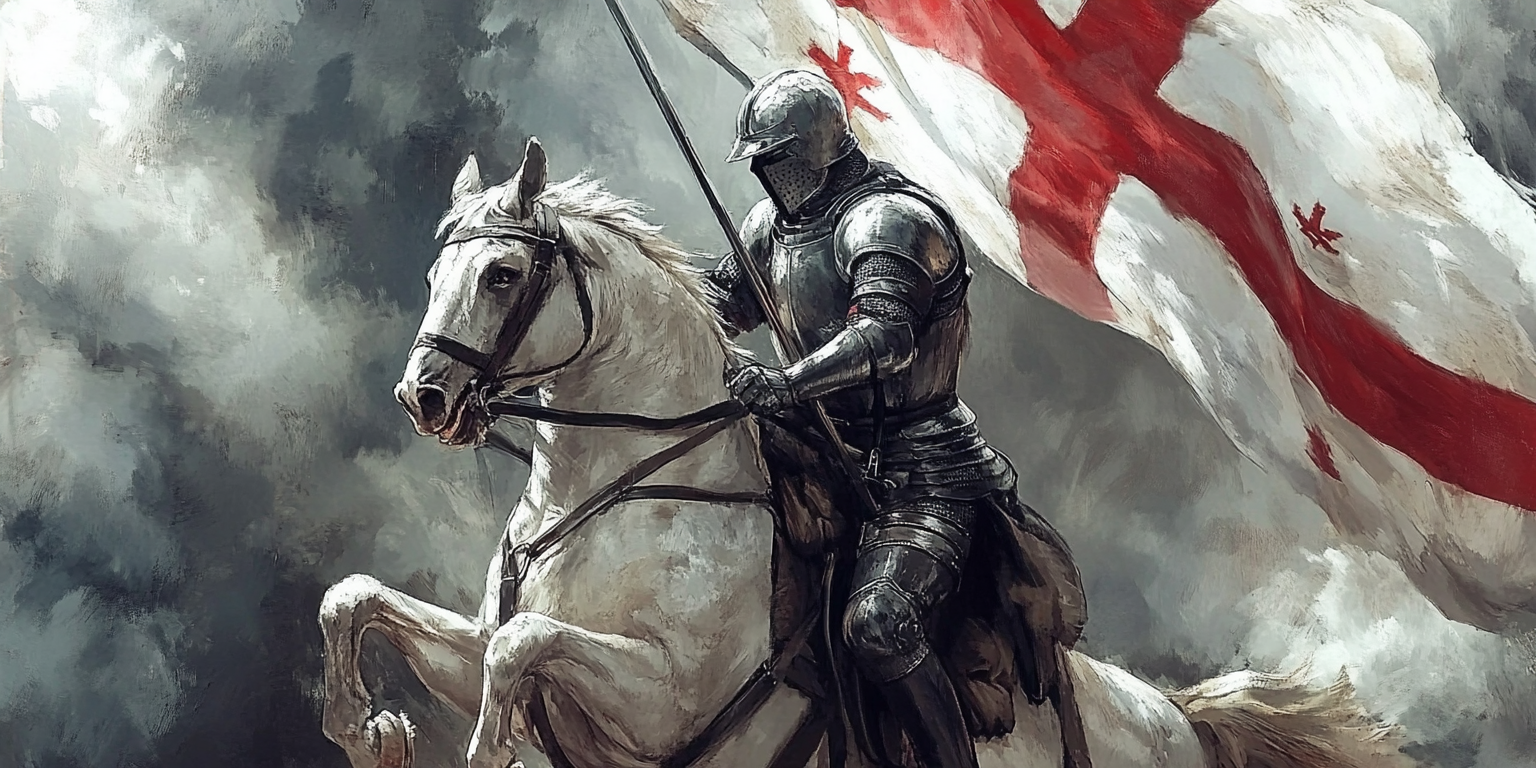St George’s Day
The Story Behind England’s Flag, Its Saint, and the Struggle for Modern Identity
Every year, on 23rd April, St George’s Day rolls around… and you’d be forgiven for barely noticing. Unlike Ireland’s Guinness-fuelled St Patrick’s Day celebrations or Scotland’s kilted homage to St Andrew, St George’s Day in England often passes with a whimper, not a roar.
But behind the quietly fluttering red-and-white flags (or the loud football chants, depending on where you are), lies a fascinating blend of myth, history, branding, and cultural identity. And in an age where symbolism is more charged than ever, it’s worth taking a proper look at how England’s patron saint became a flag-bearer for both pride and, more controversially, prejudice.
Admittedly – this article was written out of interest, rather than to help you learn marketing – but hopefully it’s of interest!
The Marketing Made Clear Podcast
Check out the Marketing Made Clear Podcast on all good streaming platforms including Spotify:
Who Was St George, Really?
Let’s start with the basics: St George wasn’t English.
He wasn’t even British.
In fact, he probably never set foot on our fair isle.
He was born around 275–285 AD in Cappadocia – a really amazing looking place, with plenty of archaeology – a region that sits in modern-day Turkey. His parents were Christians of noble heritage – his father a Roman army official, and his mother from Lydda (in modern Israel/Palestine), where George would eventually be buried.
As a young man, George followed in his father’s footsteps and joined the Roman army. He quickly rose through the ranks, gaining respect for his discipline, bravery, and leadership. But his military career was dramatically cut short under the reign of Emperor Diocletian, who launched one of the most brutal persecutions of Christians in Roman history.
Diocletian ordered that all soldiers publicly renounce Christianity and make sacrifices to the Roman gods. George refused. Not quietly, either – he tore up the edict in front of witnesses.
A bold move. And not one that ended well.
He was imprisoned, tortured, and eventually executed by beheading on 23rd April, 303 AD – the date that would later become his feast day. His unwavering faith and gruesome martyrdom earned him sainthood, and by the 5th century, he was already venerated in parts of the Christian world.
But this version of George – the steadfast Christian martyr – is only one side of the story. The George most of us picture today – riding a white horse, slaying a dragon with a lance – came centuries later, and he was riding a wave of medieval myth-making.

Enter the Dragon
The now-iconic story of George and the dragon didn’t appear until the 11th century, and was made famous by the Legenda Aurea (or Golden Legend), a wildly popular medieval book of saints’ lives compiled by Jacobus de Voragine.
According to the legend, a fearsome dragon terrorised a town (usually placed in Libya) and demanded daily human sacrifices. When the king’s daughter was next in line, along came George, who bravely fought and killed the beast. In return, the grateful townspeople converted to Christianity.
Hero saves princess, slays monster, converts nation. It’s a cracking story – perfect for stained glass windows, sermon illustrations, and later, for rallying Christian knights during the Crusades. Unsurprisingly, the dragon was never meant to be taken literally. Most historians agree it symbolised the fight against evil – whether paganism, Satan, or broader sin, depending on who was interpreting it at the time.
The tale spread quickly through Europe and became central to George’s identity, particularly as Crusader knights looked for figures who embodied righteous warfare and divine approval. By the 12th century, George had become one of the most celebrated warrior saints in Christendom.
Saint by Myth, Symbol by Design
So, George’s legend grew – not because of direct ties to England, but because of what he came to represent: courage, faith, sacrifice, and the ultimate triumph of good over evil. His story ticked every box medieval monarchs and clergy needed to inspire loyalty, zeal, and unity – particularly during times of war and religious division.
And like many great brands or public figures, his story wasn’t one consistent narrative – it was a blend of fact, fiction, reinterpretation, and cultural need. He became a canvas onto which centuries of English identity, values, and aspirations were projected.

So, Why Is He England’s Saint?
Good question.
After all, he’s also the patron saint of at least ten other countries, including Georgia, Portugal and Ethiopia. So how did he end up as England’s top guy?
The short version? Branding.
The long version? England needed a national figurehead, and St George ticked the boxes:
-
He was associated with chivalry, valour, and Christianity – useful qualities for medieval monarchs looking to unite a nation under a common religious and military identity.
-
King Edward III made him the official patron saint of England in the 14th century, establishing the Order of the Garter in his name – the oldest order of chivalry in the UK.
-
He became an emblem of Englishness during the Hundred Years’ War and again during the Crusades, when English knights wore the red cross on white.
St George wasn’t chosen because of his connection to England — he was chosen because he was useful to England.
The Flag of St George – What’s the Story?
The red cross on a white background – known as the St George’s Cross – became England’s national flag in the late Middle Ages. It wasn’t originally English either; it was first associated with the city of Genoa in Italy. English ships began flying the cross, supposedly renting the design from Genoa to protect their vessels under its powerful reputation.
Over time, the flag became a symbol of English military power and pride. During the Crusades, it adorned the tunics of soldiers and the standards of kings. Eventually, it was adopted into the Union Jack when England united with Scotland and later Ireland.
So, to recap:
-
The man is Turkish.
-
The myth is medieval PR.
-
The flag is Italian.
And yet all three became foundational parts of England’s national identity. History, as ever, is a great example of messy brand storytelling.
So Why the Negative Connotations?
Now here’s where it gets complicated.
For many people, especially post-WWII and post-Empire, the St George’s Cross became increasingly politicised. It shifted from a symbol of national pride to something uncomfortably associated with nationalism – and not the good kind.
In the late 20th century, far-right groups like the National Front and later the English Defence League began using the flag as a rallying point. It appeared on placards at anti-immigration rallies, on extremist merchandise, and in football terraces that were already struggling with racism and hooliganism.
As a result, many people – especially those from ethnic minority backgrounds – began to view the flag with suspicion. To them, it wasn’t just about “being English” – it was being used to imply that some people weren’t English enough.
It’s a masterclass in how symbols can be hijacked.
And it’s why even today, some people feel uneasy flying the flag of their own country – fearing they’ll be mistaken for aligning with views they don’t hold.
English Identity: Who Gets to Wave the Flag?
Unlike the more – debatably – unified identities of Scotland, Wales, or Ireland, Englishness is harder to pin down. And in a multicultural, globalised society, that’s both a challenge and an opportunity.
Today, efforts are being made to reclaim the St George’s Cross as a symbol of inclusivity. Initiatives like “We Are England” aim to promote a more open and diverse understanding of what it means to be English. The FA and national sports teams have also helped normalise its use again – though always with careful messaging and community engagement.
But the journey isn’t over.
National branding is delicate.
When a flag becomes a litmus test for political views, social divisions, or identity wars, it loses its unifying power.
For marketers, this is a powerful lesson.
What Can Marketers Learn from St George’s Day?
Let’s pull out a few key takeaways:
-
Symbols matter. Whether it’s a logo, a flag, or a brand colour, symbols carry emotional weight – and can be co-opted or corrupted. You don’t control how they’re interpreted once they’re out in the world.
-
Heritage is complex. Just because something has a long history doesn’t mean it’s free from controversy. Authentic storytelling requires honesty about where things come from – and who’s been left out of the story.
-
Brand identity must evolve. England’s current struggle to redefine its flag is a reminder that identity is never fixed. Relevance requires responsiveness – to people, to culture, and to context.
-
Reclamation takes work. If a symbol (or brand) has been associated with negative behaviours or ideologies, reclaiming it takes more than just rebranding. It takes consistent action, community engagement, and clear values.
Final Thoughts: A Day Worth Talking About
St George’s Day might not dominate the calendar like other national holidays, but it raises big questions about history, identity, and storytelling – the very tools marketers use every day.
Understanding where symbols come from – and how they’ve been used or misused – gives us a better chance of creating messages that unite, not divide.
So this 23rd April, whether you’re raising a flag, a pint, or an eyebrow, remember: behind every national day is a story worth unpacking. And in that story, there’s always a lesson for how we communicate, who we represent – and why it matters.


